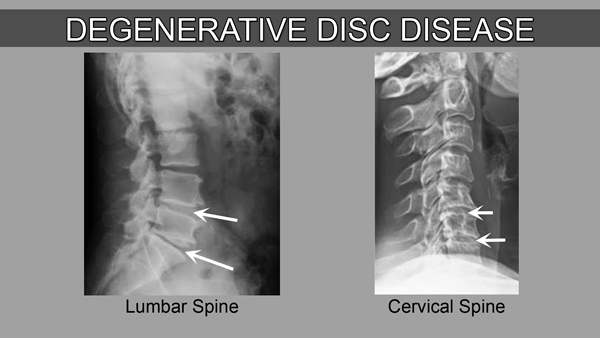Do you have degenerative disc disease in the cervical and lumbar spine? Are you looking for treatment here in the Columbus, Ohio area? Find out more about what degenerative disc disease is and how spinal decompression therapy can help.

Figure 1. Degenerative Disc Disease.
Degeneration of the inter-vertebral disc, which is often called degenerative disc disease (DDD) of the spine, is a common disorder of both the neck and lower back. In Figure 1 shown above, the white arrows are pointing to where the intervertebral disc is located in both the cervical and lumbar spine.
As you can see, the space where the disc is located is decreased and this is what is called disc degeneration. Disc degeneration can lead to other disorders such as spinal stenosis (narrowing of the spinal canal that houses the spinal cord and nerve roots), spondylolisthesis (forward slippage of the disc and vertebra), and retro-listhesis (backward slippage of the disc and vertebra).
Actually, DDD is not a disease but, rather, a degenerative condition that can be painful and can greatly affect the victim’s quality of life. Disc degeneration is a normal part of aging and is generally not a problem by itself. However, when bone spurs grow adjacent to the discs, they can pinch or put pressure on the nearby nerve roots or spinal canal, and pain can occur.
Aging is the most common cause of disc degeneration. As the body ages, the discs in the spine dehydrate, or dry out, and lose their ability to act as shock absorbers between vertebra. The most notable sign of disc degeneration however, is the decrease in disc height. This is shown in the figure below for the lumbar spine.

Figure 2. Model of lumbar spine showing various stages of disc health.
If you look closely at this model of the lumbar (lower back) spine below, every item marked #1 represents and intervertebral disc. There are a total of five of them shown. The very top one is a healthy disc. It is an off-white color. The second one down shows a disc that is in the beginning stages of degeneration.
It’s color is changed demonstrating the unhealthiness of the disc. The third one down demonstrates the beginning stages of decreased disc height. The fourth one down shows more loss in disc height along with mild bony changes (spur formation).
The fifth one shows a complete loss of disc height and severe spur formation of the vertebra above and the sacrum below. This is the most severe case of DDD.
SYMPTOMS
Often, patients suffering from DDD do not show symptoms. When symptoms are present, however, chronic low back pain sometimes radiating to the hips, or there is an aching pain in the buttocks or thighs while walking; sporadic tingling or weakness through the knees may also be evident.
Similar pain may be felt or may increase while sitting, bending, lifting, and twisting. While the degeneration of the disc will likely progress as a natural part of the aging process, pain symptoms such as low back pain often decrease over time.
TREATMENT OPTIONS
Spinal decompression therapy remains the treatment of choice to start with in regards to degenerative disc disease. Usually there is at least some part of the disc that is healthy enough to respond to therapy and because spinal decompression is non-invasive, it is typically thought of as a safe form of treatment with minimal side effects, if any.

If you have been diagnosed with degenerative disc disease in cervical & lumbar spine and are looking for treatment in the Columbus, Ohio area call our office today to see if you are a candidate for spinal decompression therapy…we can usually see you the same day you call so don’t delay.
…………………………………………